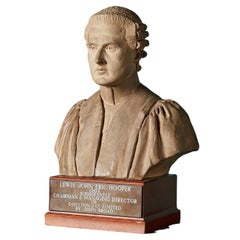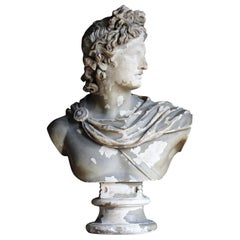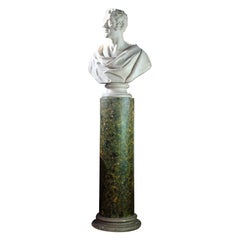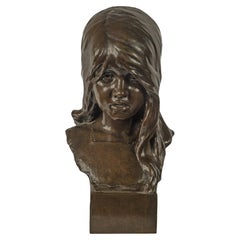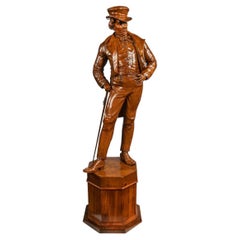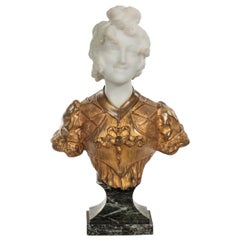England Busts
to
46
362
4
4
33
157
172
8
38
48
38
9
4
3
7
1
3
6
3
1
3
34
27
25
25
11
4
4
4
3
3
2
2
182
160
124
99
45
370
1,454
1,197
312
98
91
74
46
Height
to
Width
to
370
368
369
4
2
2
2
2
Item Ships From: England
Bust of Doulton Chairman Lewis John Eric Hooper by John Broad
Located in Wormelow, Herefordshire
Dated 1904, this stoneware bust was made by late 19th century Doulton sculptor John Broad. It depicts Lewis John Eric Hooper, descendant of John Doulton who was founder of the famous Doulton & Co. of Lambeth, London. A barrister at the time, Hooper became Managing Director of the ceramics company from 1919 and subsequently Chairman from 1925. Here he is depicted in his barrister dress by the talented hand of Broad, giving us a glimpse into the character of Hooper as well as Broad’s artistic talent for statuary. The bust is in good condition, made in stoneware and sits on a wooden plinth detailed with plaque. This bust is likely a one-off commission.
Broad was one of the most prominent artists of Doulton & Co. during the late 19th and early 20th centuries. Specialising in large works, he had a talent for producing vases, statuary and portrait medallions. This stone bust of Lewis John Eric Hooper...
Category
Early 20th Century English Victorian England Busts
Materials
Stone
19th C Classical Plaster Bust Apollo by Louis Brugiotti London Grand Tour
By Louis Brugiotti
Located in Lowestoft, GB
A fabulous 19th century oversized classical plaster bust of Apollo by Louis Brugiotti of 4 Leather Lane London 1845-1885, in original untouched condition.
89cm in height
60cm in w...
Category
Mid-19th Century English Victorian Antique England Busts
Materials
Plaster
19thC Plaster Bust on Faux Porphyry Marble Column of Architect Matthew Habershon
Located in Lowestoft, GB
A fine plaster bust of the English architect Matthew Habershon (1789-1852). The bust sits on a faux painted porphyry marble column (plaster).
The bust taken from the original marbl...
Category
19th Century English Antique England Busts
Materials
Plaster
Charming Bust of a Child’s Head by Edwin Whitney-Smith, Dated, 1910
Located in Lymington, Hampshire
A charming bust of a child’s head by Edwin Whitney-Smith, dated 1910, the girl has her head slightly tilted forwards as she looks out from under a lock of hair, set on a square block signed on the reverse ‘E Whitney-Smith 1910’.
This bronze is a reduction of Whitney-Smith’s original marble piece, a photograph of which survives in the V&A (object number AAD/1990/12/63). Another version can be seen in a 1920s photograph of the artist in his studio owned by the National Portrait Gallery (NPG x194201). Neither the identity of the sitter nor title of the work is known.
Edwin Whitney-Smith (1880-1952) was one of the pre-eminent sculptors of his day. Born in Bristol in 1880, he became a student of William Harbutt, the headmaster of Bath School of Art, best remembered today for inventing plasticine. Whitney-Smith showed great promise from an early age, opening a studio in St John’s Wood, London, in 1910. He exhibited over 40 pieces at the Royal Academy and despite not achieving Academician status, even with list of illustrious proposers, he became a dear friend of Sir Alfred Munnings, the famous horse painter, and sculpted his portrait. He was, however, elected to the Royal Society of British Sculptors and his works were generally well-received by critics and the general public alike.
Aside from the RA, he exhibited in Bristol, at the Paris Salon and the Scottish Academy and his work attracted the attention of such important patrons as the Courtauld family. One of his most famous works, The Waking Child, is in the Ferens Art Gallery in Hull and another, The Irishman, is in the Tate. One version of his bust of Ernest Bevin, the trade unionist, stands in Tooley Street in Bermondsey to this day. An article in The Sphere, published on the 3rd of May 1924, referred to the sculptor as “a well-known sculptor of smiling children” and mentioned his “famous babies’ heads”.
Category
1910s English Vintage England Busts
Materials
Bronze
Victorian carved walnut figure of Mark Tapley from the novel by Charles Dickens
Located in Lymington, Hampshire
A Victorian carved walnut figure of Mark Tapley from the novel ‘The Life and Adventures of Martin Chuzzlewit’ by Charles Dickens’, wearing a soft top hat, a tailcoat and a buttoned w...
Category
1890s English Victorian Antique England Busts
Materials
Walnut
Marble and Ormolu Bust by Marionnet
Located in Lymington, Hampshire
A marble and Ormolu bust by Marionnet, showing the white marble head and shoulders of a girl with her hair in a bun and ringlets framing her face, wi...
Category
1890s French Antique England Busts
Materials
Marble, Ormolu
19th Century Philanthropist Annie, Lady Jerningham Large Marble Bust W.R.Ingram
Located in Lowestoft, GB
A marble bust on typical waisted circular socle of Philanthropist Annie, Lady Jerningham
The bust was carved by R.W.Ingram around the last quarter of the 19th century and we beli...
Category
Late 19th Century English Late Victorian Antique England Busts
Materials
Marble
William Theed the Younger 1804-91 Marble Bust of William Ewart Gladstone 1868
Located in Lowestoft, GB
A very finely carved marble bust of William Ewart Gladstone dated 1868 and signed W.Theed SC
William Theed was born in Staffordshire, his father, William Theed the elder being a sculptor and a craftsman at Wedgwood, known for his major work, Hercules and the Thracian Horses for one frontage of the Buckingham Palace complex. The younger Theed studied at the Royal Academy Schools, then worked for the sculptor E. H. Baily. Five years on, in 1826, he went to Rome, where he was to stay a total of 22 years, during that time working in the studios of Thorwaldson and John Gibson.
Returning to London in 1848, Theed enjoyed a good reputation, being a favoured sculptor of Queen Victoria, and was commissioned to produce many portrait statues, busts, and large monuments. He showed work in the 1851 Great Exhibition, and among other high points were a group for the Albert Memorial, and five standing figures on the Inland Revenue side of Somerset House, representing Manchester, Edinburgh, Glasgow, Belfast and Dublin.
Theed's statues may be seen in St Paul's (Henry Hallam), Manchester (Monument to Chetham in the Cathedral, Gladstone and Thomas Bright for the Town Hall, and James Watt in Piccadilly Gardens), Huddersfield (Robert Peel), Winchester (David Williams monument in the Cathedral), and Prince Albert statues for Grimsby, and in Australia in Macquairie Street, Sydney. He was also responsible for three of the portrait statues (Bacon, Locke, Adam Smith...
Category
1860s English Victorian Antique England Busts
Materials
Marble
Attributed to Joseph Nollekens (1737-1823)
Located in London, GB
A COMPANION OF ULYSSES, AFTER THE ANTIQUE BUST IN THE TOWNLEY COLLECTION, NOW IN THE BRITISH MUSEUM, LATE 18TH CENTURY.
Statuary Marble.
This bust is a late 18th century English co...
Category
18th Century Antique England Busts
Materials
Statuary Marble
Price Upon Request
Ancient Marble Portrait Bust of a Bearded Man possibly Lucius Verus
Located in London, GB
This impressive bust is depicted with head turned slightly to the right and gaze lifted. His eyes are articulated, with the pupils indicated with a drill, giving the face a striking realism. The shoulders are draped with a cloak. Straight brows sit beneath a mass of thickly curling hair, which continues to a full beard. It is worked with great skill, evident in the heavy drill work articulating and highlighting the voluminous curls, and the highly polished surfaces, giving the appearance of soft skin. The contrast between these textures gives a chiaroscuro affect which is one of the main traits of the best Antonine busts.
Roman marble portraits reached their apotheosis of craftmanship and technique under the Antonine emperors, as is evidenced in this masterful bust. The evolution of the style may be traced back to the emperor Hadrian, who was the first emperor to wear a full beard. The articulation of pupils and iris appears on busts of his lover Antinous, a novelty which continued in later Antonine portraits, such as this one. The features of this bust point to a possible identification of Emperor Lucius Verus...
Category
15th Century and Earlier Antique England Busts
Materials
Marble
Price Upon Request
Recently Viewed
View AllMore Ways To Browse
Used Prosthetic Limbs
Alabaster Roman Busts
Johannes Hedegaard
Socrates Bust
Torso In Marmo
Ajax Bronze
Ajax Bust
Aristotle Sculpture
Carved Indian Bust
E Villanis Bronze Sculpture
Frilli Marble
Greek Theater Mask
Herm Bust
Marble Coupes
Medici Bust
Native American Indian Bust
Starfish Dancer
19th Century Parian Bust
